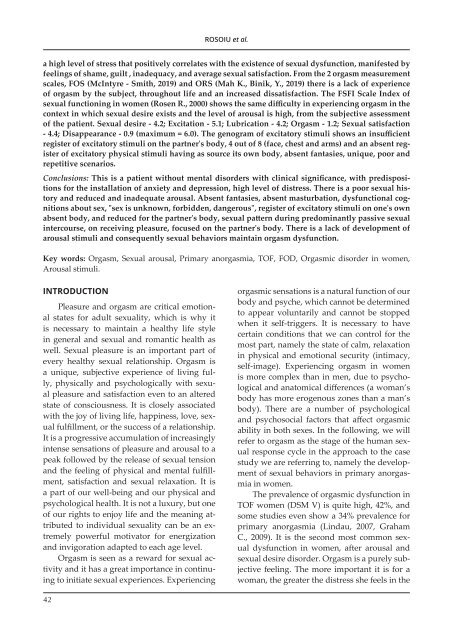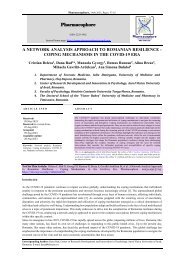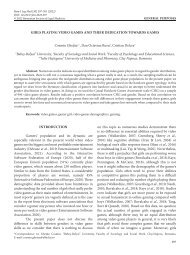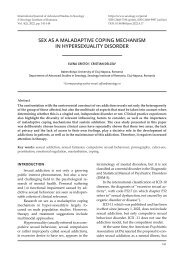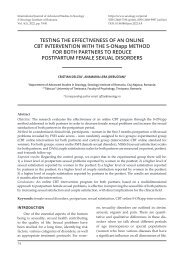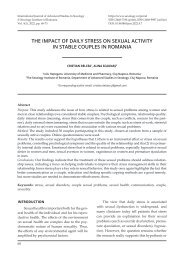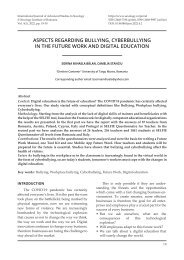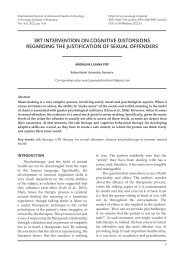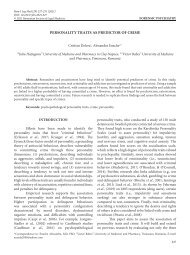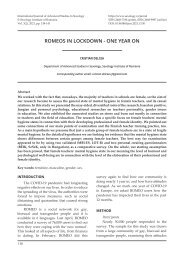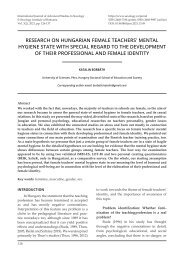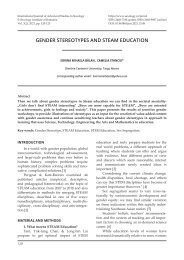Treatment of orgasm disorder in women with the digital S-ONapp method
You also want an ePaper? Increase the reach of your titles
YUMPU automatically turns print PDFs into web optimized ePapers that Google loves.
ROSOIU et al.<br />
a high level <strong>of</strong> stress that positively correlates <strong>with</strong> <strong>the</strong> existence <strong>of</strong> sexual dysfunction, manifested by<br />
feel<strong>in</strong>gs <strong>of</strong> shame, guilt , <strong>in</strong>adequacy, and average sexual satisfaction. From <strong>the</strong> 2 <strong>orgasm</strong> measurement<br />
scales, FOS (McIntyre - Smith, 2019) and ORS (Mah K., B<strong>in</strong>ik, Y., 2019) <strong>the</strong>re is a lack <strong>of</strong> experience<br />
<strong>of</strong> <strong>orgasm</strong> by <strong>the</strong> subject, throughout life and an <strong>in</strong>creased dissatisfaction. The FSFI Scale Index <strong>of</strong><br />
sexual function<strong>in</strong>g <strong>in</strong> <strong>women</strong> (Rosen R., 2000) shows <strong>the</strong> same difficulty <strong>in</strong> experienc<strong>in</strong>g <strong>orgasm</strong> <strong>in</strong> <strong>the</strong><br />
context <strong>in</strong> which sexual desire exists and <strong>the</strong> level <strong>of</strong> arousal is high, from <strong>the</strong> subjective assessment<br />
<strong>of</strong> <strong>the</strong> patient. Sexual desire - 4.2; Excitation - 5.1; Lubrication - 4.2; Orgasm - 1.2; Sexual satisfaction<br />
- 4.4; Disappearance - 0.9 (maximum = 6.0). The genogram <strong>of</strong> excitatory stimuli shows an <strong>in</strong>sufficient<br />
register <strong>of</strong> excitatory stimuli on <strong>the</strong> partner's body, 4 out <strong>of</strong> 8 (face, chest and arms) and an absent register<br />
<strong>of</strong> excitatory physical stimuli hav<strong>in</strong>g as source its own body, absent fantasies, unique, poor and<br />
repetitive scenarios.<br />
Conclusions: This is a patient <strong>with</strong>out mental <strong>disorder</strong>s <strong>with</strong> cl<strong>in</strong>ical significance, <strong>with</strong> predispositions<br />
for <strong>the</strong> <strong>in</strong>stallation <strong>of</strong> anxiety and depression, high level <strong>of</strong> distress. There is a poor sexual history<br />
and reduced and <strong>in</strong>adequate arousal. Absent fantasies, absent masturbation, dysfunctional cognitions<br />
about sex, "sex is unknown, forbidden, dangerous", register <strong>of</strong> excitatory stimuli on one's own<br />
absent body, and reduced for <strong>the</strong> partner's body, sexual pattern dur<strong>in</strong>g predom<strong>in</strong>antly passive sexual<br />
<strong>in</strong>tercourse, on receiv<strong>in</strong>g pleasure, focused on <strong>the</strong> partner's body. There is a lack <strong>of</strong> development <strong>of</strong><br />
arousal stimuli and consequently sexual behaviors ma<strong>in</strong>ta<strong>in</strong> <strong>orgasm</strong> dysfunction.<br />
Key words: Orgasm, Sexual arousal, Primary an<strong>orgasm</strong>ia, TOF, FOD, Orgasmic <strong>disorder</strong> <strong>in</strong> <strong>women</strong>,<br />
Arousal stimuli.<br />
INTRODUCTION<br />
Pleasure and <strong>orgasm</strong> are critical emotional<br />
states for adult sexuality, which is why it<br />
is necessary to ma<strong>in</strong>ta<strong>in</strong> a healthy life style<br />
<strong>in</strong> general and sexual and romantic health as<br />
well. Sexual pleasure is an important part <strong>of</strong><br />
every healthy sexual relationship. Orgasm is<br />
a unique, subjective experience <strong>of</strong> liv<strong>in</strong>g fully,<br />
physically and psychologically <strong>with</strong> sexual<br />
pleasure and satisfaction even to an altered<br />
state <strong>of</strong> consciousness. It is closely associated<br />
<strong>with</strong> <strong>the</strong> joy <strong>of</strong> liv<strong>in</strong>g life, happ<strong>in</strong>ess, love, sexual<br />
fulfillment, or <strong>the</strong> success <strong>of</strong> a relationship.<br />
It is a progressive accumulation <strong>of</strong> <strong>in</strong>creas<strong>in</strong>gly<br />
<strong>in</strong>tense sensations <strong>of</strong> pleasure and arousal to a<br />
peak followed by <strong>the</strong> release <strong>of</strong> sexual tension<br />
and <strong>the</strong> feel<strong>in</strong>g <strong>of</strong> physical and mental fulfillment,<br />
satisfaction and sexual relaxation. It is<br />
a part <strong>of</strong> our well-be<strong>in</strong>g and our physical and<br />
psychological health. It is not a luxury, but one<br />
<strong>of</strong> our rights to enjoy life and <strong>the</strong> mean<strong>in</strong>g attributed<br />
to <strong>in</strong>dividual sexuality can be an extremely<br />
powerful motivator for energization<br />
and <strong>in</strong>vigoration adapted to each age level.<br />
Orgasm is seen as a reward for sexual activity<br />
and it has a great importance <strong>in</strong> cont<strong>in</strong>u<strong>in</strong>g<br />
to <strong>in</strong>itiate sexual experiences. Experienc<strong>in</strong>g<br />
<strong>orgasm</strong>ic sensations is a natural function <strong>of</strong> our<br />
body and psyche, which cannot be determ<strong>in</strong>ed<br />
to appear voluntarily and cannot be stopped<br />
when it self-triggers. It is necessary to have<br />
certa<strong>in</strong> conditions that we can control for <strong>the</strong><br />
most part, namely <strong>the</strong> state <strong>of</strong> calm, relaxation<br />
<strong>in</strong> physical and emotional security (<strong>in</strong>timacy,<br />
self-image). Experienc<strong>in</strong>g <strong>orgasm</strong> <strong>in</strong> <strong>women</strong><br />
is more complex than <strong>in</strong> men, due to psychological<br />
and anatomical differences (a woman’s<br />
body has more erogenous zones than a man’s<br />
body). There are a number <strong>of</strong> psychological<br />
and psychosocial factors that affect <strong>orgasm</strong>ic<br />
ability <strong>in</strong> both sexes. In <strong>the</strong> follow<strong>in</strong>g, we will<br />
refer to <strong>orgasm</strong> as <strong>the</strong> stage <strong>of</strong> <strong>the</strong> human sexual<br />
response cycle <strong>in</strong> <strong>the</strong> approach to <strong>the</strong> case<br />
study we are referr<strong>in</strong>g to, namely <strong>the</strong> development<br />
<strong>of</strong> sexual behaviors <strong>in</strong> primary an<strong>orgasm</strong>ia<br />
<strong>in</strong> <strong>women</strong>.<br />
The prevalence <strong>of</strong> <strong>orgasm</strong>ic dysfunction <strong>in</strong><br />
TOF <strong>women</strong> (DSM V) is quite high, 42%, and<br />
some studies even show a 34% prevalence for<br />
primary an<strong>orgasm</strong>ia (L<strong>in</strong>dau, 2007, Graham<br />
C., 2009). It is <strong>the</strong> second most common sexual<br />
dysfunction <strong>in</strong> <strong>women</strong>, after arousal and<br />
sexual desire <strong>disorder</strong>. Orgasm is a purely subjective<br />
feel<strong>in</strong>g. The more important it is for a<br />
woman, <strong>the</strong> greater <strong>the</strong> distress she feels <strong>in</strong> <strong>the</strong><br />
42


